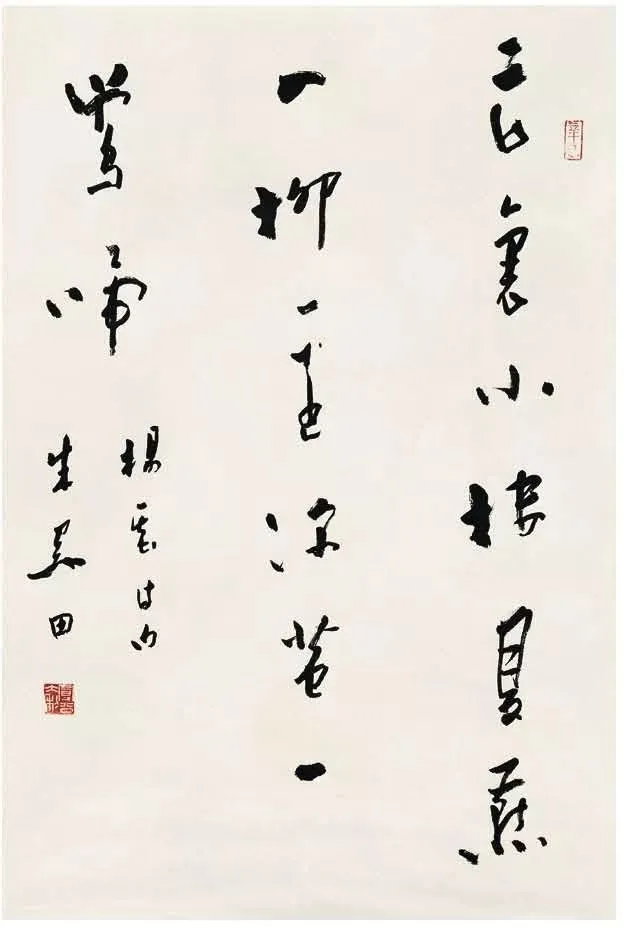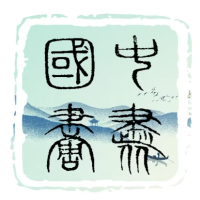朱关田,字曼倬,乙酉年春生于越州。沙孟海先生年四十赠字“曼倬”,寓意志远而行慎,学贵细致。朱氏自承教诲,终身以艺为志,潜心于文脉传承。
其学书始自秦篆汉隶,点画圆劲,气韵沉厚,草书点势之妙,盖得篆隶之根基。继而研章草,笔法犹戈戟,粗细相间,和谐自成,姿态生动。朱氏章草兼融大篆与魏碑笔意,线条凝练,点画饱满,字形宽博,章法疏密有致,落笔重厚,收笔露锋,笔意清雄,灵动洒脱,气韵高迈,意境古拙而浑成。观其作品,结构如星斗错落,笔锋藏而不露,气机畅达,笔墨间自显天真厚朴,深藏不露,尽显文人风骨。

中国书道,自古迭代更迁,创新与传承相生。书法虽属文化一隅,然其间涵括哲学、美学、文字、考据,皆有所涉。前贤于书艺之外,常研碑帖、文字训诂,积累甚丰,然典籍浩如烟海,精华与糟粕并存,言辞晦涩,波诡云谲,真伪难辨。朱氏静心研习,以隋唐书史为主,阐幽发微,厘清疑难,去芜存真,厘明脉络。唐代书法,正如其文学一般,蔚为大观,气象万千,远迈魏晋,独步宋元,后世名家莫不承其风范。朱氏沉潜于此,探得精义,风骨自成,气象开阔,诚为当代书坛巨擘。




朱关田三十载潜心隋唐书史,笔耕不辍,研理穷微,文史互参,探幽发微,成就斐然。其以隋唐为中心,勾勒书法脉络,阐明时代文化与书艺之互动,论及唐代书法品评之标准,不仅关乎技艺,更系帝王好尚与家族渊源。此种以文史融书理,开一代新风,卓然有成,独步书坛。其在《隋唐五代书法史》中,深入考证,揭示隋唐五代书风变迁,构筑出当代隋唐书法史之坚实大厦。朱氏书艺,学术为本,艺理交融,实证学说。其研习书道,遍及古今,追索传统高峰,于创作中探索自家风貌。观其笔作,遒劲饱满,线条古拙而不失灵动,气韵雄浑高古,兼具天真洒脱,尽显其文化根柢与独特个性。
朱关田工书,尤重形法,取对比与统一为规,笔意纵横,气势融通。其运笔圆劲,线条遒密,字形雍容自若,宽博而不失法度。笔墨畅达,神韵内敛,结构严谨而灵动,左旁右展,妙合天然,观者每感沉静中蕴蓄雄劲之力。章法精妙,行距错落有致,气脉连贯而气势磅礴。笔断意连,处处金石之韵流转,隐见古拙雄浑之风。其书求简逸清雅,结体奇而不失正,笔力沉而不滞,气机自然松而有度,源自章草提炼化裁。朱氏艺理深邃,崇尚和雅,以篆隶为根,碑学静穆与二王清气相融,气象独特,自成一家。书外善印,治印精工,承潘天寿四艺通融之旨,融书画诗印于一体,雅韵绵长,气度高远,古今交汇,卓然于艺坛。




朱关田于治学染翰之余,亦精治印。观其《思微室印存》,印风古雅纯正,品格上乘。朱氏所治大印,雄浑朴厚,犹如“江启大象日利”之作,沉稳有力。其边款清朗自然,未见矫饰,坦然自成,非凡俗之辈所能拟想。朱氏治印,简洁无华,不求浮艳,自见古意深远。此等功力,非久历砚田,操刀数十载,不易得至,正如古人云:“庾信文章老更成”,斯艺境所成,诚为艺林所珍。




Zhu Guantian: Exploring the Depths of Art, Unleashing Grand Visions Through Brushstrokes
Zhu Guantian, styled Manzhuo, was born in the spring of the yǐyǒu year in Yuezhou. At the age of forty, the renowned calligrapher Sha Menghai gifted him the name "Manzhuo," meaning "to aim high and act with prudence, with learning rooted in meticulous detail." Zhu took this teaching to heart and dedicated his life to the inheritance of cultural tradition and artistic pursuit.
He began his study of calligraphy with Qin seal script and Han clerical script, mastering the rounded, forceful strokes that convey profound depth. His understanding of cursive script’s dynamic strokes stems from this foundational training in seal and clerical scripts. Later, Zhu delved into zhangcao, a form of cursive script known for its vivid strokes reminiscent of spears and halberds, harmoniously balanced between rough and fine. Zhu infused his zhangcao with elements from large seal script and Wei stele, imbuing his work with a sense of gravity and balance. His strokes are solid yet nimble, forming characters that are wide and expansive. The structure of his work flows like scattered stars across the Milky Way, with brushstrokes that hide their sharpness yet exude power and fluidity, revealing the essence of scholarly refinement.
Chinese calligraphy has evolved through constant innovation and continuity, with each era contributing to its growth. Though calligraphy might seem a small branch of traditional culture, it intersects deeply with philosophy, aesthetics, linguistics, and more. Scholars of the past did not merely practice calligraphy; they examined stele inscriptions, studied the etymology of characters, and refined their techniques. Yet, the wealth of material left behind—voluminous and complex—holds both wisdom and confusion. In response, Zhu Guantian, with a quiet and steady scholar’s heart, has devoted thirty years to the study of Sui and Tang calligraphy, elucidating unclear points and addressing contradictions in historical interpretations. The Tang dynasty, like its literature, represented the height of cultural achievement, shaping calligraphy into a form that reached beyond the past and influenced future generations. Zhu, through his dedication, has unveiled the essential qualities of Tang calligraphy, firmly establishing his place as a leading scholar in the field.
For thirty years, Zhu Guantian has focused on researching the calligraphy of the Sui and Tang dynasties, consistently yielding impressive results. His approach, which intertwines historical study with the evolution of calligraphy, reveals that the standards of calligraphic evaluation in the Tang dynasty were not solely based on artistic merit but were also influenced by imperial preferences and familial ties. This method of combining history with the analysis of artistic trends has opened new pathways in calligraphic research. His magnum opus on the calligraphy of the Sui and Tang dynasties has shaped the foundation for contemporary calligraphic scholarship. Zhu's work is not merely theoretical; it actively informs his artistic practice, where he explores and refines his unique style atop the peaks of traditional Chinese calligraphy. His brushwork is vigorous and his lines full, blending ancient simplicity with beauty, reflecting his deep cultural heritage and distinctive artistic personality.
Zhu Guantian's calligraphy emphasizes form and structure, following the principles of contrast and unity. His brushstrokes are rounded and vigorous, with lines that are compact yet flowing, giving his characters a grand, expansive quality without losing precision. His ink flows freely, embodying a restrained elegance, while the overall structure remains rigorous yet dynamic. Each stroke and character is balanced, with the left and right extending naturally, giving the work a quiet but potent strength. His mastery of composition is evident in the rhythmic spacing and harmonious flow of energy throughout his pieces. Every break in the brush is filled with intent, and his work resonates with a sense of timeless strength. Zhu's calligraphy seeks simplicity and elegance, blending the raw beauty of ancient scripts with his own refined style. His work is rooted in the traditions of seal and clerical script, blending the solemnity of stone inscriptions with the elegance of Wang Xizhi's line, creating a distinct, individual style that spans the ages.
In addition to his achievements in calligraphy and scholarship, Zhu Guantian is also an accomplished seal carver. His works, collected in Siwei Studio Seal Collection, exhibit an ancient, authentic style. The seals Zhu creates are simple yet profound, such as the "Jiang Qi Da Xiang Ri Li" seal, which is robust and full of life. His side inscriptions are clear and natural, without artifice, radiating a tranquil elegance that only decades of dedication to the craft can produce. Zhu's achievements in seal carving are a testament to his lifelong commitment to the art, embodying the wisdom of the saying, "With age, the writings of Yu Xin grew even finer." His work stands as a cherished gem within the art world.
责任编辑:苗君
